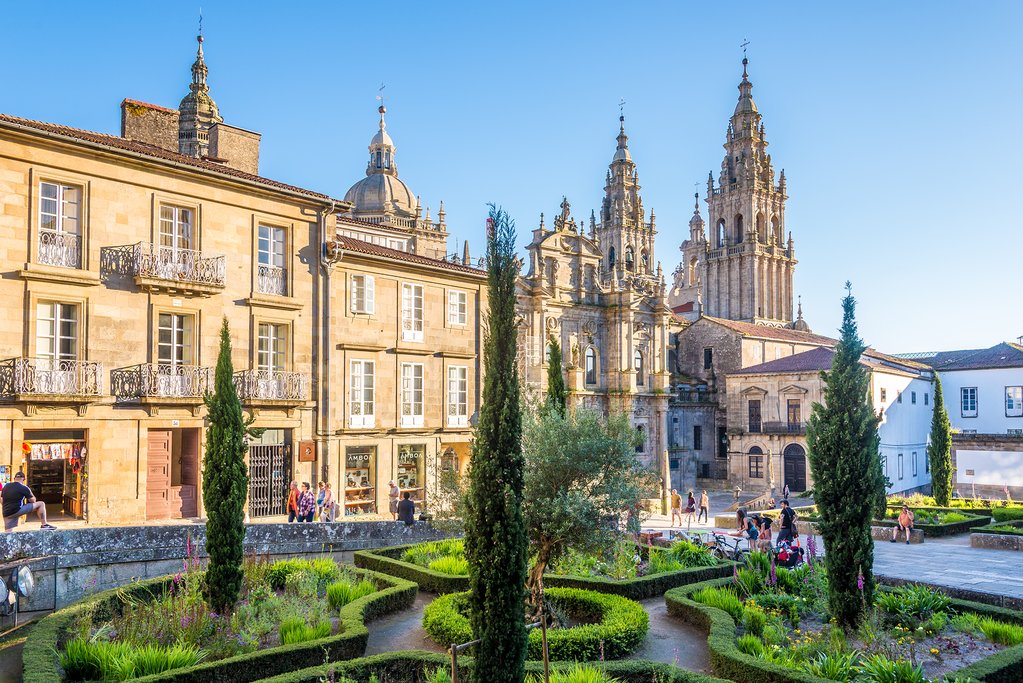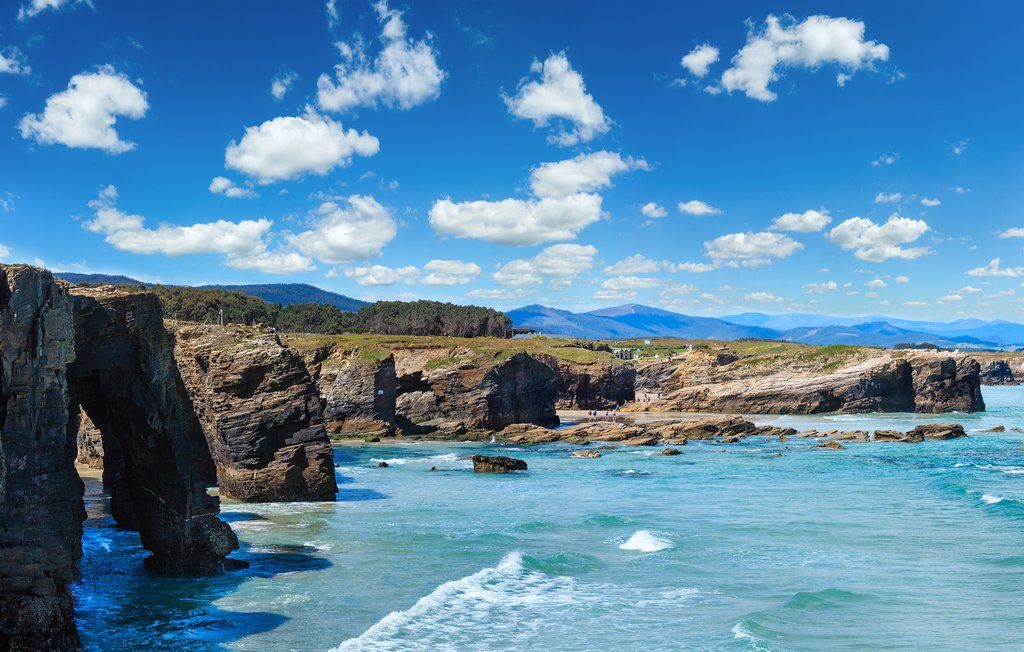Highlights
- Travel the pilgrimage route and stop at beautiful locales in Galicia
- Take a boat tour through the Ribera del Duero wine region
- Enjoy the white-sand beaches of the Cíes Islands
Brief Itinerary
| Day | Highlights | Overnight |
|---|---|---|
| Day 1 | Arrival in Santiago | Santiago de Compostela |
| Day 2 | Cooking Class & City Tour of Santiago | Santiago de Compostela |
| Day 3 | Drive to Ribeira Sacra - Boat Tour - Drive to Vigo | Vigo |
| Day 4 | Day Trip to the Cíes Islands | Vigo |
| Day 5 | Depart Spain |
Detailed Itinerary
Day 1: Arrival in Santiago

Welcome to Santiago de Compostela! This historic city is both the capital of Spain's Galicia region and the culmination point of the Camino de Santiago, the historic pilgrimage route.
Upon arrival at the airport, your driver will pick you up and transfer you to your hotel for check-in. You'll likely be tired from all the travel, but you should still head out for a walk around this fascinating city. Santiago abounds with medieval architecture and grand plazas, and a self-guided tour of these highlights is a perfect excuse to stretch your legs after your long journey.
Day 2: Cooking Class & City Tour of Santiago

In the morning, you'll discover the secrets to Galician cuisine in a cooking class with a private chef. You'll prepare (and eat) some of the region's most popular dishes, like fried padrón peppers and savory empanadas stuffed with fish, shellfish, or meat. Be sure to try queimada, the famous "Galicia fire drink." Made with a liqueur called orujo (similar to grappa), it's mixed in a clay bowl with sugar and lit on fire until the flame turns blue then served hot.
In the afternoon, you'll embark on a guided tour of the main sites in Santiago. This includes Obradoiro Square, at the east end of which sits the Cathedral of Santiago de Compostela. Construction on this Romanesque/Gothic/Baroque church began in the 11th century over the site of what is believed to be the burial place of the apostle Saint James the Great. It's been a religious pilgrimage site since the Middle Ages and marks the end of the famous Camino de Santiago walking route.
Other stops include Colexio de San Xerome (San Jerónimo College), a learning institution dating to 1501; the 16th-century Hospital de los Reyes Católicos, a hospital built to treat weary pilgrims after their arduous journey; the Pazo de Raxoi (Raxoi Palace), an 18th-century neoclassical palace that's now Santiago's City Hall; and the 18th-century San Fructuoso Church. Here you can witness pilgrim rituals and see the Botafumeiro, which is the largest silver-plated censer in the world.
Chat with a local specialist who can help organize your trip.
Day 3: Drive to Ribeira Sacra - Boat Tour - Drive to Vigo

In the morning you'll drive a couple hours southeast from Santiago to Ribeira Sacra, a mountainous river canyon of unparalleled beauty. Remote and lesser-developed than many parts of Spain, since the 12th century, this area was primarily home to monks and hermits who came to live ascetic lives near the confluence of the rivers Sil and Miño.
The River Sil winds between green mountains and through canyons, affording some uniquely incredible views. You'll witness them on a 1.5-hour riverboat tour of Ribeira Sacra, where you can bask amid gorgeous scenery that includes sloping hills and high plateaus. Also here, flourishing amid the cypress and chestnut trees, is another bit of vegetation famous throughout the region: grapevines.
Yes, Ribeira Sacra is a fertile grape-growing region that enjoys Designation of Origin (D.O.) status for its wine production. It's uniquely referred to as "heroic viticulture" because, due to the steepness of the mountains and hills, most vineyards here are terraced. With so many vines hanging off the sides of hills and canyons, the simple act of grape-harvesting in Ribeira Sacra requires much deftness and agility.
After the boat tour, you'll head to a local guesthouse where the friendly hosts will prepare a homemade meal for you to enjoy. Then you'll hop back in the car and drive a couple of hours west to the coastal city of Vigo, where you'll overnight.
Day 4: Day Trip to the Cíes Islands

About 10 miles (16 km) west of Vigo, off the coast of Spain, lie the Cíes Islands. This archipelago is a national marine park comprised of three islands so beautiful that the ancient Romans called them the "islands of the gods." Two of them, Monte Agudo and O Faro, are linked by a crescent strip of fine white sand called Rodas Beach, one of the most beautiful beaches in the world. You'll get to discover this paradise on a private, day-long boat tour accompanied by an expert guide.
In the morning, you'll embark from the port at Vigo and first head to a group of nearby Spanish fjords known as Rias Bajas. These beautiful inlets serve a functional purpose in that it's here where Galicians harvest much of their famously delicious shellfish. The microclimate in the waters of these fjords makes an ideal breeding ground for scallops as well as perfect spots to cultivate mussels and oysters.
After stopping on the islands for some beach time and light hiking, you'll enjoy lunch onboard the ship. This will be a delicious gourmet meal featuring locally sourced products, including some of that world-class shellfish. Afterward, you'll return to Vigo and will have the remainder of the day free to enjoy however you wish.
Day 5: Depart Spain

It's time to say farewell to Spain! Depending on the time of your flight or train reservation, squeeze in one more morning of sight-seeing, perhaps picking up some last-minute souvenirs. At the designated time you will be picked up at your hotel and transferred to the airport or rail station for your departure onwards.


